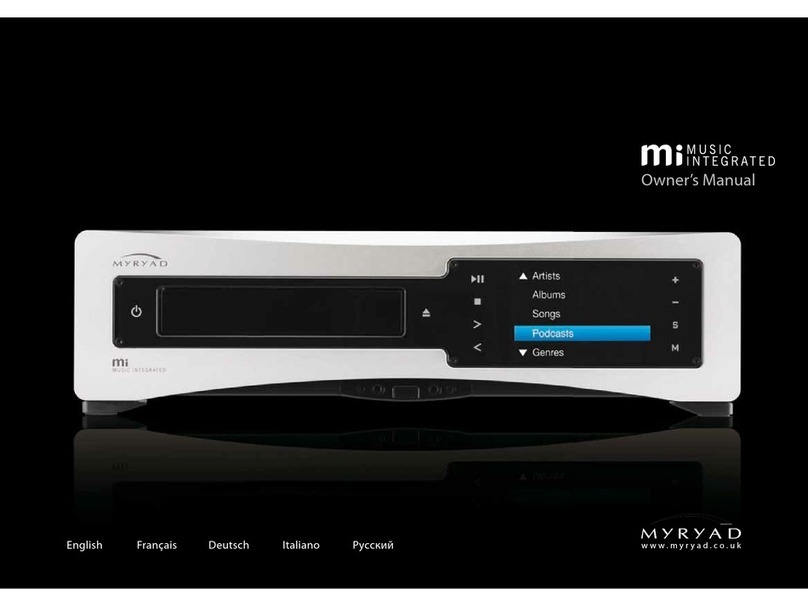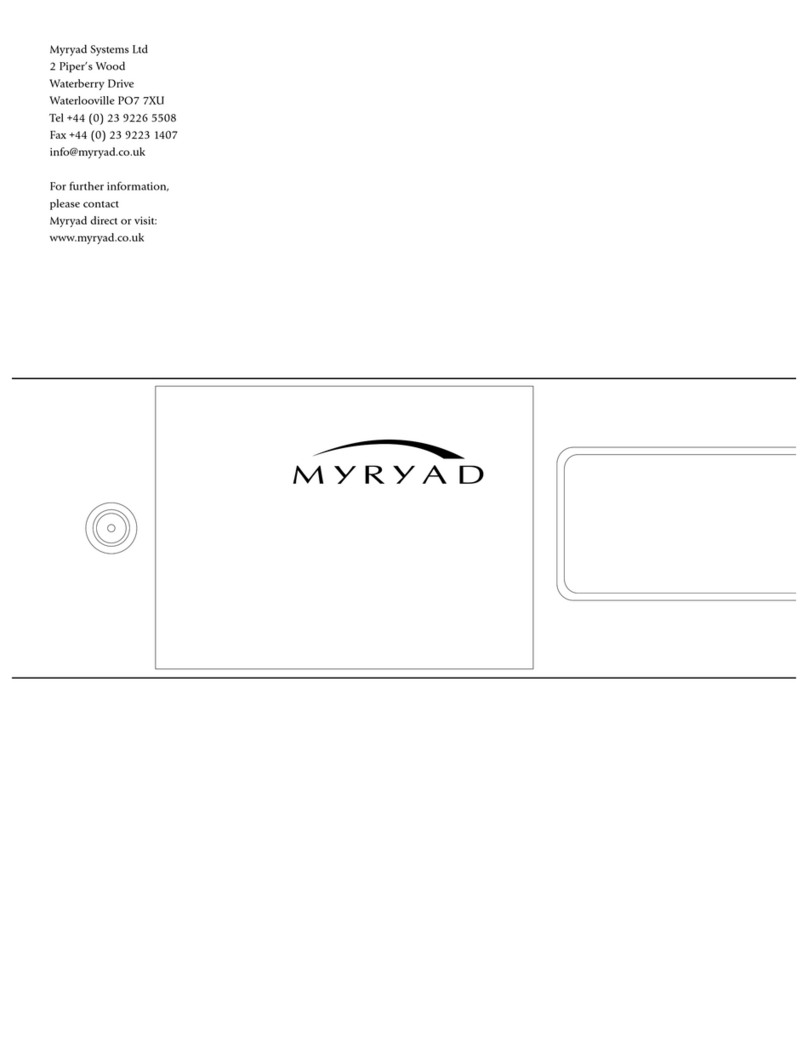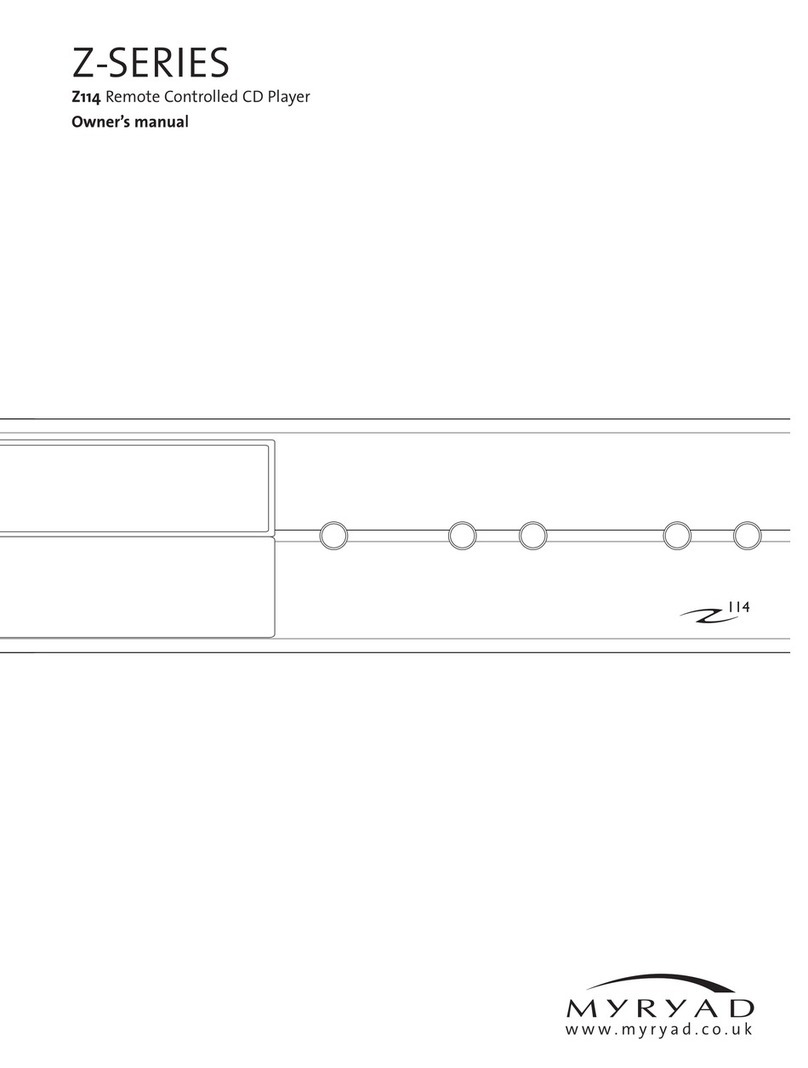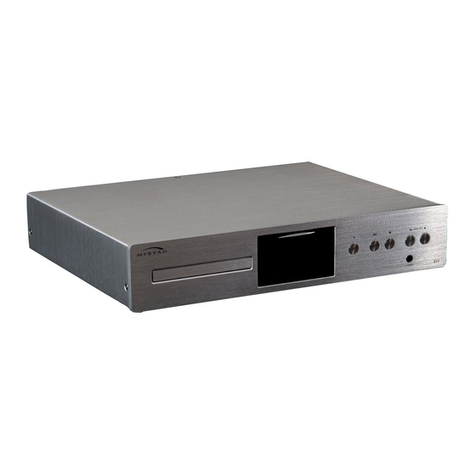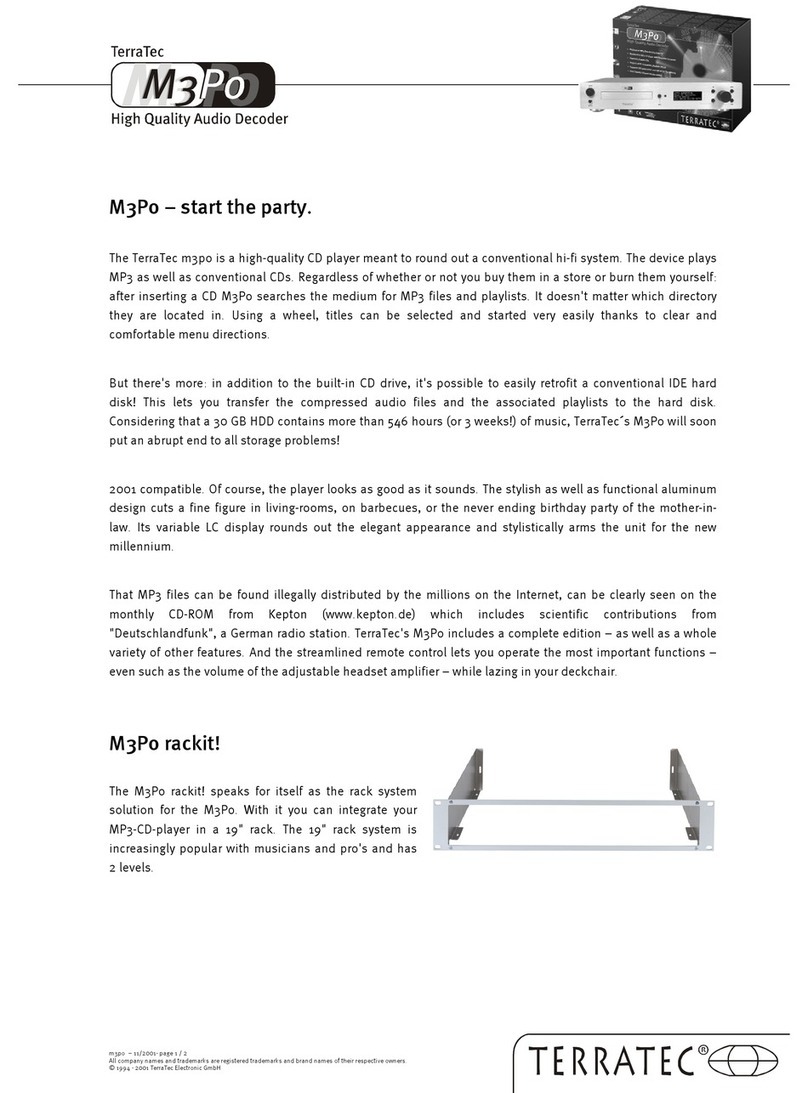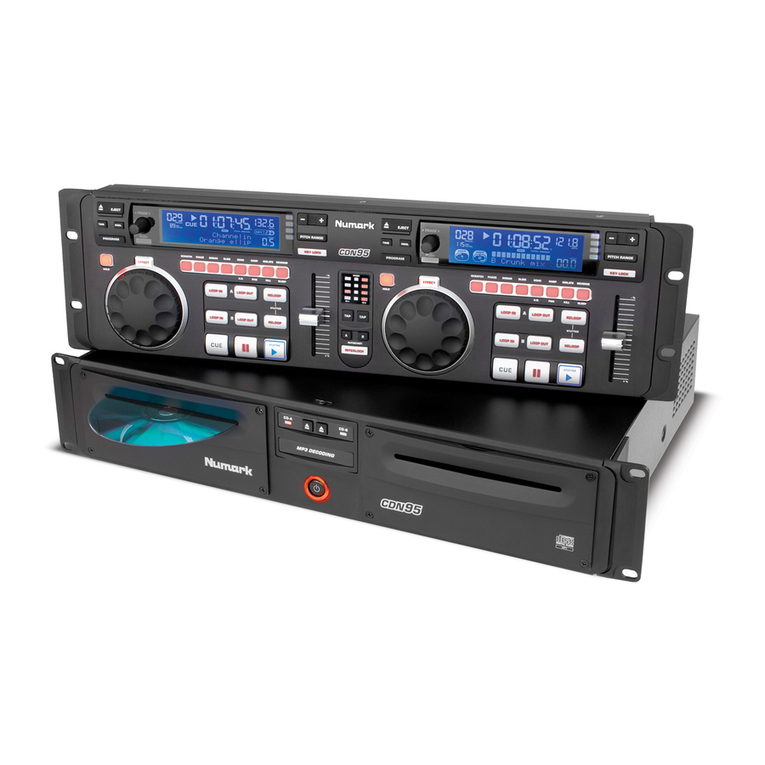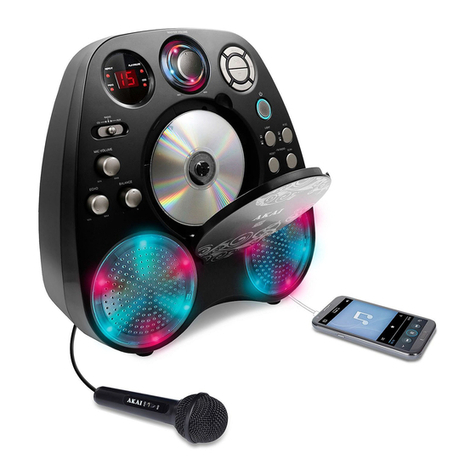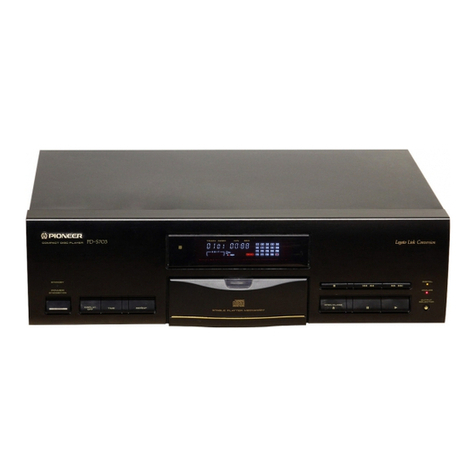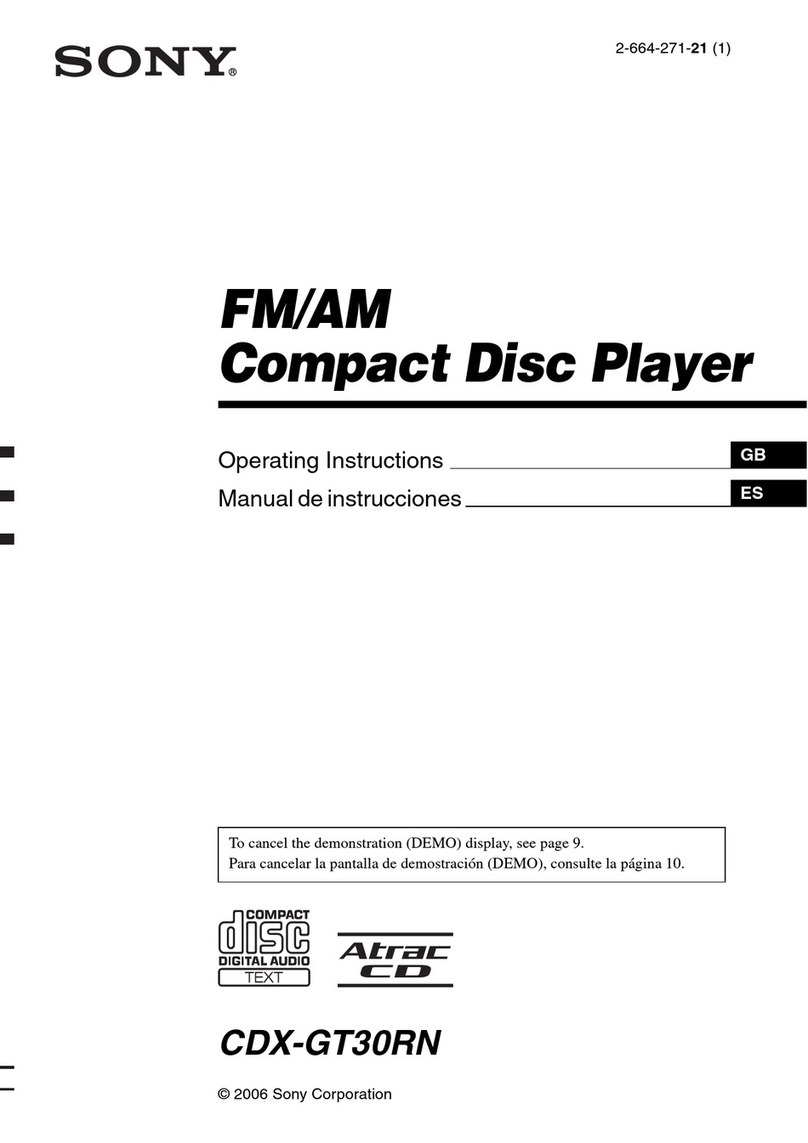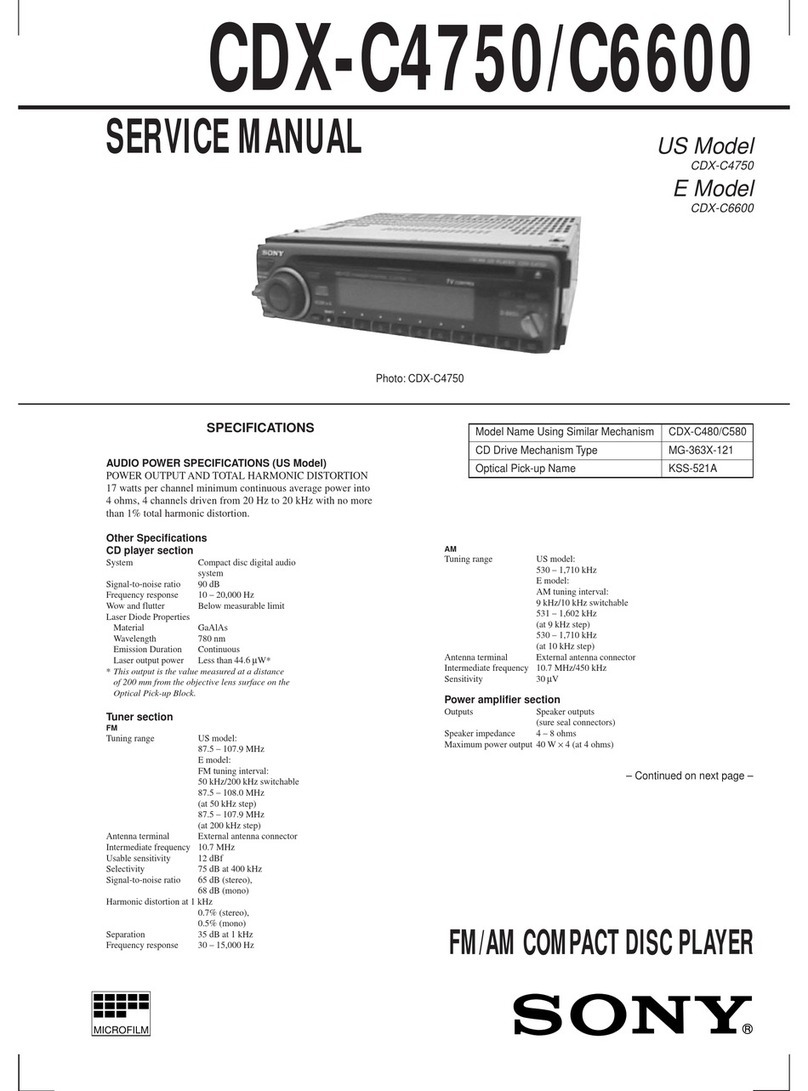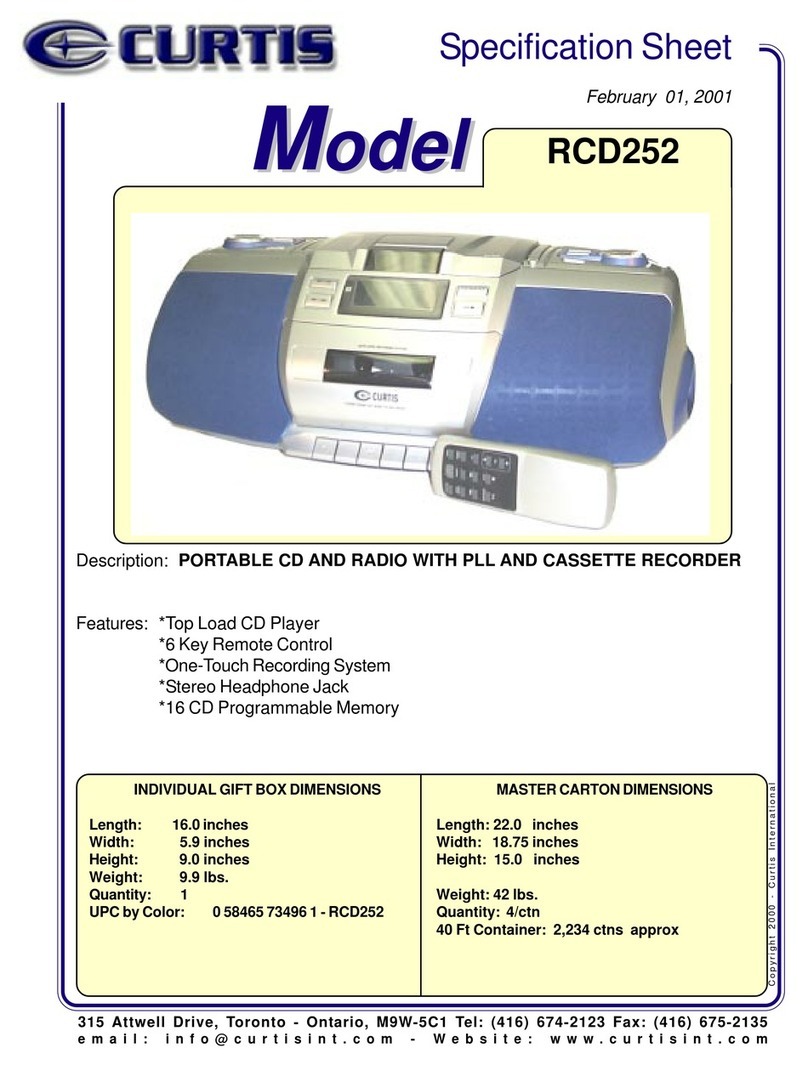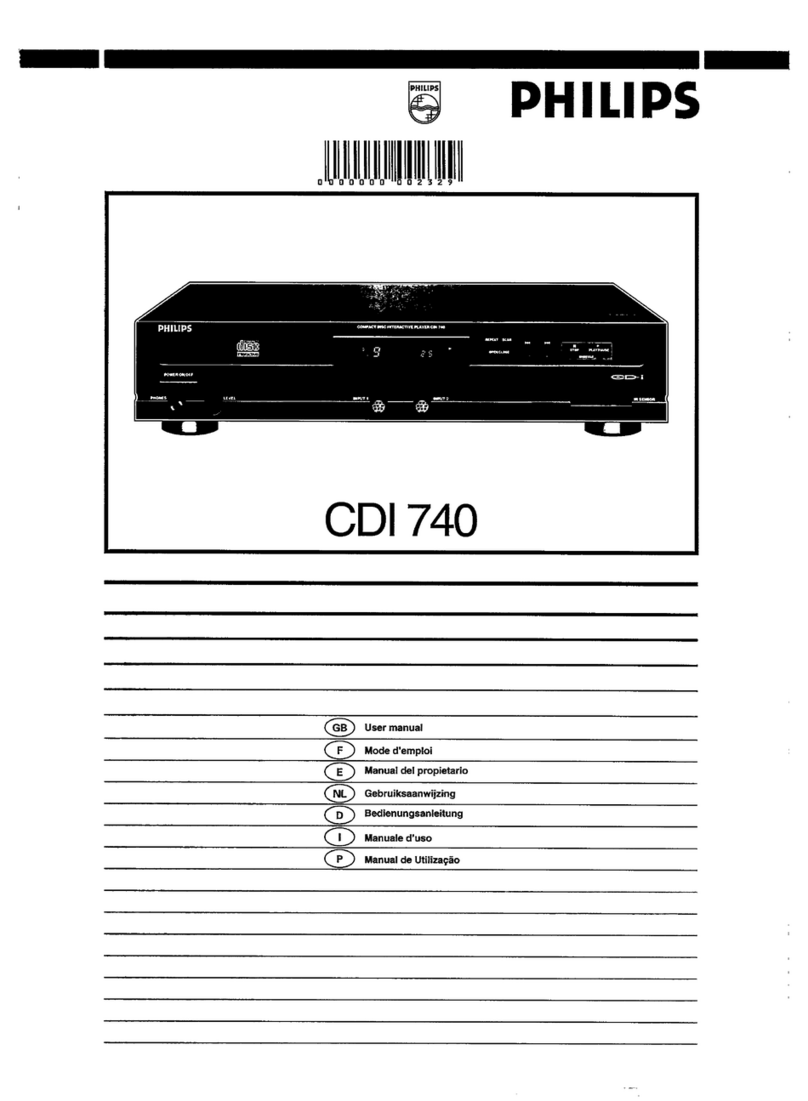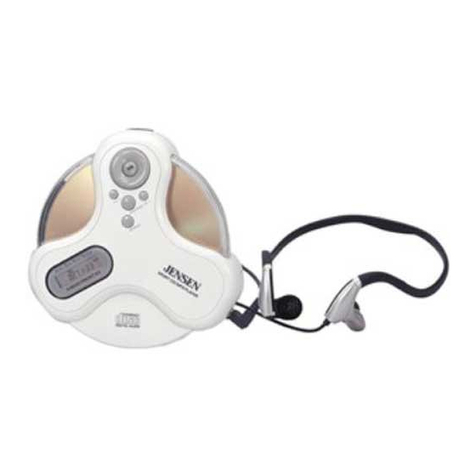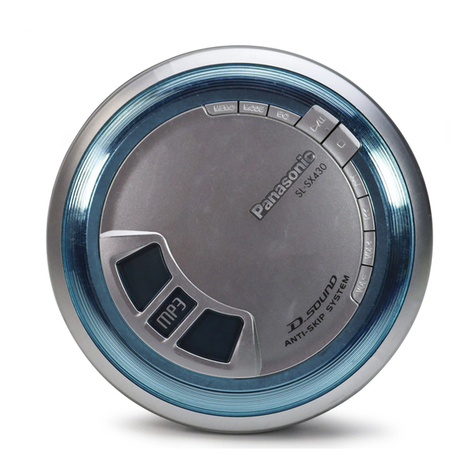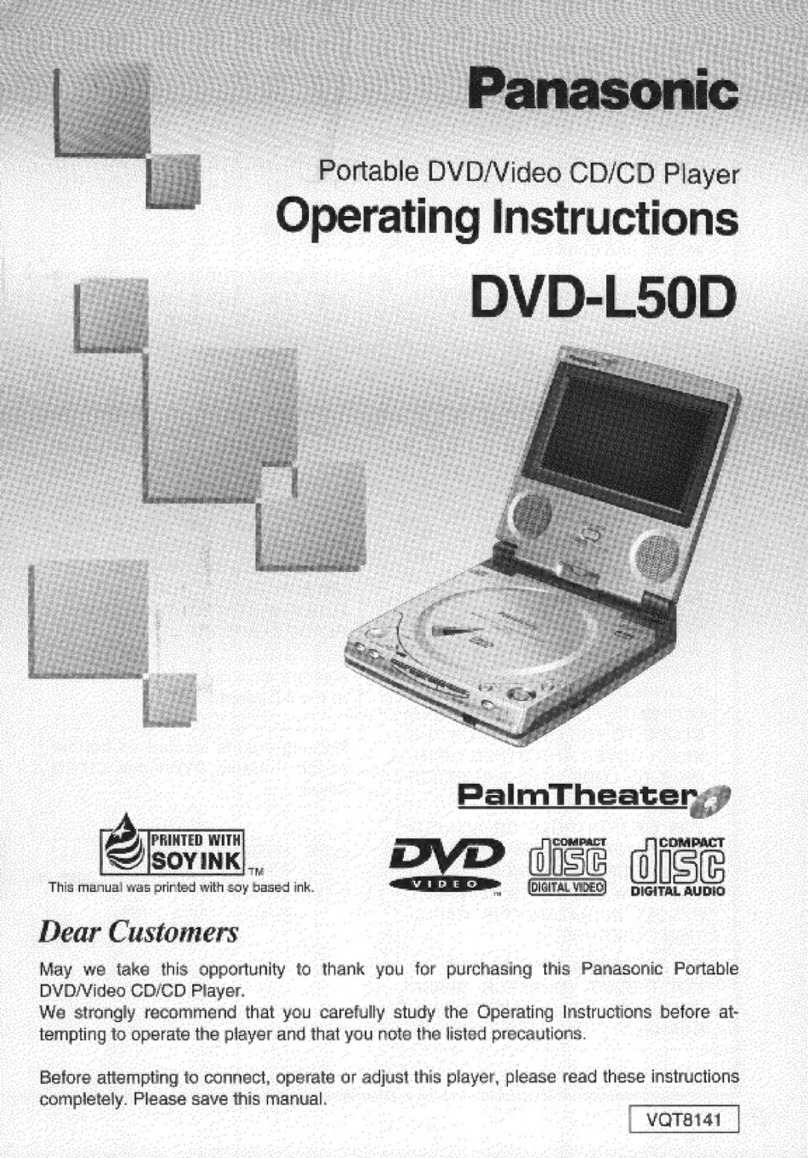Myryad MCD 200 User manual

Myryad Systems Ltd
2 Piper’s Wood
Waterberry Drive
Waterlooville PO7 7XU
Tel +44 ( ) 23 9226 55 8
Fax +44 ( ) 23 9223 14 7
info@myryad.co.uk
For further information,
please contact
Myryad direct or visit:
www.myryad.co.uk
All manuals and user guides at all-guides.com
all-guides.com

mcd 200/600
Remote Controlled Compact Disc Players
Owner’s manual
All manuals and user guides at all-guides.com

2
content
• Introduction 2
• Installation and safety notes 2
• Accessories 2
• Setting up your CD player
Rear panel connections 3
• Operating your CD player
Front panel controls 4
• Remote control handset operation 5
• System operation with
‘Smart My Link’ 6
• Installing and replacing batteries 7
• Care and handling of compact discs 7
• Trouble shooting guide 7
• Specifications 7
accessories
Your MCD 2 /6 is supplied complete
with the following accessories:
• Separate mains power cord to suit
country of sale.
• My-link interconnect ( .5m RCA-RCA)
• Remote control handset.
• Two AAA batteries for handset
(not in some countries).
introduction
The Myryad MCD 2 and 6 Compact
Disc Players have been designed to offer
a combination of high quality sound
reproduction and elegant styling in keeping
with other Myryad products. Both models
operate in exactly the same way, but the
MCD 6 has more advanced internal
circuitry resulting in greatly improved sound
quality. For simplicity this manual refers only
to the MCD 6 but all sections apply equally
to the MCD 2 – with the sole exception of
the Specifications which are given separately
for each model.
The MCD 6 is a full-function remote-
controlled CD player. It has fixed-level
low-impedance audio outputs to drive
a Myryad integrated amplifier or pre-
amplifier – or other high quality amplifier.
In addition the MCD 6 has a digital
output on a single RCA phono socket
(SPDIF standard), suitable for driving
a separate DAC (Digital-to-Analogue-
Converter), and a ‘Smart My-Link’
control input and output.
The MCD 6 offers a range of expansion
possibilities:
• The digital output can be used to feed
a separate DAC or digital recorder.
• The My-Link input can be connected
to a Myryad integrated amplifier or
pre-amplifier so that the MCD 6 will
automatically be switched on or off when
the amplifier is switched on or off.
• The My-Link input/output can be coupled
to other Myryad products that can then
be remote-controlled via the MCD 6 ’s
infra-red receiver – or vice-versa.
•When linked via the ‘Smart My-Link’ to
a compatible Myryad integrated amplifier
or preamplifier a number of extra features
become available which make the system
as a whole easier and quicker to operate.
installation and
safety notes
This CD player generates very little heat but
still requires some ventilation. Do not place
it on a rug or other soft surface into which
it could sink, obstructing the air inlets in its
underside. Do not allow any obstruction to
the ventilation slots in the rear panel. The
CD player should not be installed in a built-
in situation such as a bookcase or rack unless
proper ventilation is provided.
CAUTION: TO PREVENT A FIRE OR SHOCK
HAZARD, DO NOT PERMIT THIS PRODUCT TO
BECOME WET. IF LIQUID IS ACCIDENTALLY
SPILLED ON IT, IMMEDIATELY SHUT OFF ITS
POWER AT THE WALL SOCKET AND UNPLUG
THE AC POWER CORD. ALLOW SUFFICIENT
TIME FOR COMPLETE EVAPORATION TO OCCUR
BEFORE OPERATING THE UNIT AGAIN. IF THE
LIQUID IS ANYTHING BUT WATER AND/OR
ALCOHOL, A QUALIFIED SERVICE TECHNICIAN
SHOULD EXAMINE THE UNIT BEFORE IT IS
USED AGAIN.
Do not remove the cover, or attempt to
modify or repair the CD player yourself. Refer
all servicing to a qualified technician. The CD
laser radiation is Infra-Red, so you cannot see
it. If the cover is removed for any reason, you
MUST pay attention to the following warning.
CAUTION – INVISIBLE LASER RADIATION WHEN
OPEN. DO NOT STARE INTO BEAM OR VIEW
DIRECTLY WITH OPTICAL INSTRUMENTS.
ATTENTION – RADIATION INVISIBLE DU LASER
QUAND OUVERT. NE PAS REGARDER FIXEMENT
LE RAYON OU DIRECTEMENT AVEC DES
INSTRUMENTS D’OPTIQUE.
WARNUNG – UNSICHTBARE LASERSTRAHLEN
IN GEÖFFNETEM ZUSTAND VORHANDEN.
NICHT IN DEN STRAHL BLICKEN BZW DIREKT
MIT OPTIKINSTRUMENTEN ANSEHEN.
ADVARSEL – USYNLIG LASERSTRÅLING VED
ÅBNING. SE IKKE IND I STRÅLEN – HELLER IKKE
OPTISKE INSTRUMENTER.
ADVARSEL – USYNLIG LASERSTRÅLING NÅR
DEKSEL ÅPNES. STIRR IKKE INN I STRÅLEN
ELLER SE DIREKTE MED OPTISKE
INSTRUMENTER.
VARNING – OSYNLIG LASERSTRÅLNING
NÄR DENNA DEL ÄUOR ÖPPNAD. STIRRA EJ
IN I STRÅLEN OCH BETRAKTA EJ STRÅLEN MED
OPTISKA INSTRUMENT.
VAROI AVATAESSA OLET ALTTIINA
NÄKYMÄTÖNTÖ LASERSÄTEILYLLE. ÄLÄ
TUIJOTA SÄTEESEEN ÄLÄKÄ KATSO SITÄ
OPTISEN LAITTEEN LÄPI.
This product complies with DHHS 21 CFR
Chapter 1, Subchapter J.
All manuals and user guides at all-guides.com

3
power
off on
class 1
laser product
my-link
out in
rl
line
output
digital
output
rear panel
connections
1Power inlet
Before making any connection, check that
the mains voltage setting printed on the rear
panel is the same as your local mains supply.
Plug the female (socket) end of the power
cord into the power inlet on the rear of the
CD player. Plug the male (plug) end of the
cord into a ‘live’wall socket or a suitable
heavy-duty extension cable.
UK version: The mains plug is supplied fitted
with a 5A fuse. It should only be replaced
with a fuse of the same rating (5A) which
complies with BS1362.
2Power switch
Press one side of this rocker switch (the side
nearer the edge of the rear panel) to switch
the CD player ON and the other side
(towards the output sockets) to switch it OFF.
When the POWER switch is in the OFF
position all power is disconnected from the
CD player. In this condition the CD player
cannot be powered up from the front panel
or the remote control. When the POWER
switch is in the ON position (and the power
cord correctly inserted and plugged in to
a live wall socket) the CD player will power
up in standby mode (see FRONT PANEL
CONTROLS, STAND BY, page 4).
It is recommended that the POWER switch
is turned OFF if the CD player is not going
to be used for an extended period of time.
3Digital output
This is a serial electrical digital output to the
‘SPDIF’ standard. It should be connected via
a suitable interconnect to the SPDIF input
of a separate DAC (Digital-to-Analogue-
Converter), digital pre-amp or digital
recorder. The cable should be of standard
75Ω impedance for best performance.
4MY LINK input/output
When this CD player is used in a system
with other Myryad products (e.g. M-Series
or Cameo), all may be joined together via the
My-Link. The My-Link is a communications
bus that allows all the linked components
to operate together as a system and distributes
the remote commands received by any one
to each of the others. The simplest function
provided by the My-Link bus is that all linked
units will switch into or out of standby mode
when the amplifier’s front panel or remote
control standby key is pressed.
Use a short RCA-to-RCA (phono-to-phono)
interconnect cable to connect from the
MY-LINK IN socket on the MCD 6 to
the MY-LINK OUT socket on the amplifier.
A second cable may then be run from the
MY-LINK OUT socket on MCD 6 to
the MY-LINK IN socket on a Myryad tuner
– ‘daisy-chain’ fashion. Further compatible
Myryad products can be linked in the same
way, running from the MY-LINK OUT socket
on the tuner. Inexpensive interconnects may
be used as the My-Link bus carries only
control signals, not audio, so these cables
have no effect on sound quality.
When Myryad products equipped with ‘Smart
My-Link’ are connected via the My-Link many
more powerful system features are available
(see page 6).
5 Line outputs
These outputs are suited to the ‘CD’ or other
‘Line’ inputs (e.g. TUNER or AUX) of any
integrated amplifier or pre-amplifier. Never
connect to the amplifier’s PHONO inputs.
setting up your
system
All manuals and user guides at all-guides.com

front panel
controls
1Standby
When the CD player is plugged into a live
wall socket and the POWER switch is turned
ON, it will power up in ‘standby‘ mode and
the LED (Light Emitting Diode) in the
STANDBY button will glow red. In this mode
the internal circuitry of the MCD 6 is
powered up but disabled, so that it consumes
very little power and its audio output is
muted by a relay.
When the STANDBY button is pressed the
MCD 6 ’s circuitry will be activated and,
after a few seconds delay, the audio outputs
will be enabled. During this delay period the
LED in the STANDBY button will flash blue.
When the outputs are un-muted it will glow
blue continuously. The blue-coloured display
will illuminate, briefly showing a single digit
‘ ’, followed by ‘-NO DISC-’.
When the STANDBY button is pressed again
the CD player will be returned to standby
mode. The drawer, if open, will close, the
LED in the STANDBY button will glow red
again and the display will be extinguished.
CAUTION: WHEN IN STANDBY MODE THE
INTERNAL CIRCUITRY OF THE MCD 600 IS
STILL LIVE, SO ALL SAFETY PRECAUTIONS MUST
BE FOLLOWED.
2Infra red receiver
The infra-red (IR) remote control receiver
is mounted behind the window, just above
the display. It must not be obscured when the
CD player is to be operated using the remote
control handset. Where possible it is best to
arrange that the IR receiver is in ‘line-of-sight’
of the remote handset.
Whole CD display (Figure 1)
3Display
The operation of the player is indicated
on a high quality blue Vacuum Fluorescent
Display (VFD). Track number, index number
and track time are shown simultaneously,
together with indication of the operating
mode – see Figure 1.
4Disc drawer
The OPEN/CLOSE button controls the
drawer. The drawer will close automatically
if left open for 6 seconds or more. It will
accept either normal 12 mm CDs, or small
8 mm CDs.
5Open/close
Press this button to open or close the disc
drawer. The drawer may also be closed by
pushing the drawer front gently. When the
drawer is open the display will indicate track
number ‘ ’. When the drawer is closed with
no disc in the player the display will indicate
‘-NO DISC-’.
Table of contents (Figure 2)
When a disc is inserted and the drawer closed
the CD player will read the disc’s Table of
Contents (TOC) and display the total number
of tracks and total playing time of the disc.
After about 4 seconds the display will revert
to showing just ‘ ’. This condition is called
STOP mode.
If there is ‘CD text’ information present on
the disc the symbol ‘CD TEXT’ will illuminate
and the TOC will be displayed for about 4
seconds, after which the display will indicate
the disc title, scrolling it across the display
screen if necessary.
6 Play/Pause
When a disc is present and the player in
STOP mode, a single press of the PLAY/PAUSE
key will start the disc playing from the first
track, and illuminate thesymbol. When the
disc is playing, pressing PLAY/PAUSE will put
the player in PAUSE mode and illuminate
(see Figure 3). In PAUSE mode the disc
is still spinning and the laser head is kept at
the same location, so that if PLAY/PAUSE
is pressed yet again the disc will re-start from
exactly the same point in the music at which
it was originally paused.
With the disc drawer open, it is possible
to load a disc and press PLAY/PAUSE directly
(without pressing OPEN/CLOSE). This action
causes the drawer to close and the disc to
start playing from the first track. The TOC
is not displayed.
Pause mode (Figure 3)
4
standby
play/pause skip/scan
stopopen/close
operating your
system
Track calendar
All manuals and user guides at all-guides.com

7Stop
When the STOP button is pressed the music
stops playing, the disc stops spinning and
the laser head is returned to the beginning of
the disc. The player is now in STOP mode.
The player automatically returns to STOP
mode when a disc has finished playing.
8Skip/scan
The SKIP/SCAN keys are used to select the
track, or section within a track, to be played.
A brief press of one of these keys invokes
the SKIP function. Pressing the key and
holding it down continuously invokes the
SCAN function.
While a disc is playing, pressing SKIP/SCAN
briefly will cause the player to skip to the
beginning of the next track. If SKIP/SCAN
is pressed once, the player will skip to
the beginning of the current track. If
SKIP/SCANis pressed twice in quick
succession the player will skip to the
beginning of the previous track. Repeated
pressing of SKIP/SCANorwill make the
player skip forward or back over any number
of tracks. When playing the last track of
a disc, SKIPhas no effect. The SKIP/SCAN
keys have the same function in PAUSE mode.
The SKIP function may also be used in STOP
mode to select a track number. If PLAY/PAUSE
is then pressed within about 1 seconds, the
disc will start playing from the selected track.
The SCAN function is used to select a specific
passage within a music track. While a disc
is playing, pressing SKIP/SCANorand
holding it down continuously will cause the
laser to scan rapidly forward (or backward)
through the music. Snatches of music will be
heard through the loudspeakers at a reduced
volume level. In PAUSE mode the SKIP/SCAN
function has a similar effect, but the scanning
is faster and there is no sound from the
loudspeakers. If, when playing the last track
of a disc, an attempt is made to scan beyond
the end of the track, the display will show
‘-OVER-’. This condition can be corrected
by pressing SKIP/SCAN.
remote control
handset
operation
The handset supplied with the MCD 6 has
been ergonomically designed to be easy and
comfortable to use.
The seven keys towards the top right of the
handset (STOP, PAUSE, PLAY, SKIP,
SCAN) function in a similar way to their
counterparts on the front panel. The green
STANDBY key at the bottom left of the
handset operates in exactly the same way as
the STANDBY button on the front panel.
Play and pause
The handset has separate keys for PLAY and
PAUSE. Pressing PLAY from STOP mode will
cause the disc to start playing. Subsequent
pressing of PLAY whilst during PLAY mode
will have no effect. If PAUSE is pressed during
PLAY mode, then the player goes into PAUSE
mode. The player can be returned to PLAY
mode either by pressing PAUSE again or by
pressing PLAY.
Pressing PAUSE in STOP mode will set
the player into PAUSE mode with the disc
spinning and the laser aligned at the
beginning of the first track. When PLAY
or PAUSE is then pressed the music will
start playing instantly.
Skip
The remote control SKIP keys carry out
exactly the same SKIP function as the front
panel keys, but they cannot perform the
SCAN function. If one of the remote SKIP
keys is pressed and held down continuously
the player will skip repeatedly from track to
track (forward or backward as appropriate).
Scan
These keys allow direct access to the SCAN
function which can also be accomplished
by pressing and holding down one of the
front panel SKIP/SCAN keys.
Shuffle
When the SHUFFLE key is pressed ‘SHUFFLE’
will be shown briefly in the display and the
SHUFFLE icon will light at the bottom of
the display. When PLAY is pressed the tracks
on the disc will be played in random order.
In SHUFFLE mode, when any track ends,
the remaining unplayed tracks are ‘shuffled’
for about a second and a random new track
selected. Pressing SKIPwill cause the player
to shuffle and select a new track. Pressing
SKIPwill cause the player to re-start the
current track. It is not possible to skip back
to the previous selection.
Pressing SHUFFLE again returns the player
to normal operation.
Time (including CD Text)
When there is no CD text information present
on the disc the TIME key controls only what
is shown in the time (MIN and SEC) section
of the display. During normal play and
in pause mode the display shows the elapsed
time of the track currently being played
– see Figure 3. If TIME is pressed once,
the remaining time of the current track is
displayed. The remaining time of the current
track is not indicated for tracks numbered 25
or greater. If TIME is pressed again, the
remaining time of the whole disc is displayed
and the track number is blanked. When
remaining time is displayed, the time is
preceded by a ‘–’ sign. A third press of the
TIME key returns the display to the normal
indication of elapsed track time.
If TIME is pressed in STOP mode, the total
number of tracks and the total disc time are
displayed (i.e. the TOC) for a few seconds.
When there is CD text information on the
disc the symbol ‘CD TEXT’ will illuminate
at the bottom right of the display and the
TIME key will have additional functions.
While playing a track, the display will
normally show the track title – see Figure 4.
If the TIME key is pressed the display will
change to show the elapsed time of the
current track. A second press will display the
remaining time for the current track and a
third press will display the remaining time for
the whole disc. Finally, a fourth press will
return to the track title display
If TIME is pressed in STOP mode, the display
will switch from displaying the disc title to
displaying the artist (and ‘ART’ will illuminate
at the top right of the display). A second press
will display the TOC (the total number of
tracks and total disc time). After a few seconds,
or if TIME is pressed again, the display will
revert to showing the disc title again.
CD text – track title (Figure 4)
Repeat
A single press of the REPEAT key puts the
player into REPEAT ALL mode and ‘REPEAT’
will be shown briefly in the display. When
the disc has played to the end it will
immediately return to the first track and start
playing again – ad infinitum. When the
REPEAT key is pressed a second time, REPEAT
1 mode is engaged and ‘REPEAT 1’ will be
shown briefly in the display. Only the current
track will then be repeated. A third press of
5
All manuals and user guides at all-guides.com
all-guides.com

6
the REPEAT key returns the player to normal
operation. The repeat mode (REPEAT or
REPEAT 1) is also shown by the small icons
at the bottom of the display.
Track number keys
Direct access to any track is possible using
the numbered keys on the remote handset.
To play a specific track (e.g. track 26) press
the track number keys ‘2’ then ‘6’. After the
second key is pressed the player will play
track 26. If only one key (e.g. key ‘2’) is
pressed, the player will pause briefly before
playing track 2.
DIM (Calendar and Display Off)
The DIM key may be used to activate the
track calendar or to switch the display off
while a disc is playing. The first press of
the DIM key will switch on the track calendar
at the right hand side of the display. The
calendar displays the number of the current
track and all the other tracks that have
not yet been played. It can be particularly
useful when programming, when it
indicates only the numbers of the tracks
already programmed.
A second press of the DIM key will switch the
player into DISPLAY OFF mode and turn the
display off. A third press will turn the display
on again. When the display is switched off,
operation of any of the player’s controls – on
the front panel or remote control – will cause
the display to switch on for about 2 seconds,
before it switches off again.
If there is no disc playing (i.e. disc in STOP
or PAUSE mode or no disc) the first press of
the DIM key will not blank the display but it
will still switch the player into Display Off
mode – indicated briefly by ‘DISPLAY OFF’
in the display. In this mode, when a disc is
played the display will switch off after about
2 seconds. The Display Off mode can be
cancelled at any time by pressing the DIM
key again.
Program
An individual compilation of tracks may be
played by using the PROGRAM function.
Up to 24 tracks can be included in a program
in any order – including repeats of the same
track if desired. The procedure for storing
a program is as follows:
In STOP mode first press the PROGRAM key
to enter Program mode. The display will
indicate PROGRAM briefly and illuminate
PROGRAM at the bottom of the display.
Next, using the SKIP keys (or the
SKIP/SCAN buttons on the front panel),
select the first track you wish to program. The
word ‘STEP’ will illuminate at the top of the
display with the number ‘1’ below it and the
selected track number will flash. When you
have selected the correct track number press
the PROGRAM key again to store this track
as step 1 of the program. Then select the
next track number and store it by pressing
PROGRAM – and so on. The display will
show the track number to the left, the
program step number in the centre, and the
total program time on the right – see Figure 5.
Program mode (Figure 5)
The same procedure is repeated until all the
desired tracks have been programmed – up
to the maximum of 24. If an attempt is made
to program further tracks, the display will
briefly indicate PROGRAM FULL. The total
program time will not be indicated if it
exceeds 99 minutes and 59 seconds.
The programmed selection can then be
played by pressing PLAY on the remote
handset, or PLAY/PAUSE on the front panel.
All the other controls function as normal,
but SHUFFLE is not available. The display
will indicate track number, index and time
as during normal play, but PROGRAM will
remain illuminated to indicate PROGRAM
play. The TIME function allows display of
the remaining track time or the remaining
time of program.
Check
To confirm a program in STOP mode, press
the CHECK key and the first programmed
track, STEP 1, will be displayed – as in Figure
5. Each time the CHECK key is pressed, the
display will move on to the next track in the
program. Once the last programmed track
is reached, a further press of CHECK will
cause the display to read ‘END’ briefly and
then return to the last program step. A further
press of CHECK will return to step 1. CHECK
may also be used during PROGRAM play,
when the first press will indicate the track
currently being played.
Clear
If, while programming a sequence of tracks,
you make an error, just press CLEAR to erase
the last track programmed. To erase a track
from the middle of a program, first select the
track using the CHECK key as above, then
press CLEAR to erase the displayed track.
To erase an entire program, press STOP to go
into STOP mode and then press the CLEAR
key and hold it down for about 2 seconds
until the display reads ‘CLEAR’.
system operation
with smart
my-link
When used as a linked system (e.g. Integrated
Amplifier, CD Player and Tuner), Myryad
products equipped with ‘Smart My-Link’ have
a number of extra features that make the
system as a whole easier and quicker to use
than a normal hi-fi. These include:
Start on Play (CD)
Press play on the CD player (or the remote
control) and both the CD player and
amplifier will switch out of standby
(if necessary) and play the CD. The amplifier
will automatically select the CD source.
Start on Open (CD)
With the units in standby, press open/close
on the CD player and both the CD player and
amplifier will switch out of standby and the
CD drawer will open. The amplifier will
automatically select the CD source.
Intelligent Input Selection (Amplifier)
Press a source select button on the remote
control and the system will awaken
(if in standby) only the amplifier and
the selected source.
Mute/Pause Control (Amplifier/CD)
When using the CD player, selecting mute
from the remote control will mute the
amplifier and pause the CD. When the
amplifier mute is cancelled, the CD will
continue playing.
Power Saving Mode (Amplifier)
The amplifier will switch the CD Player or
Tuner into standby if either source remains
unused for more than ten minutes.
Automatic Switch On (CD/Tuner)
If the standby button on the tuner or CD
player is pressed, the amplifier will also
awaken and select the correct source.
All manuals and user guides at all-guides.com

7
care and
handling of
compact discs
• To remove the disc from its storage case,
press down in the centre of the case
and lift the disc out, holding it carefully
by the edges.
• Always place the CD in the disc drawer
with the label facing upwards. CDs can be
played on one side only.
• Fingerprints and dust should be carefully
wiped off the disc’s signal surface (shiny
side) with a soft cloth. Unlike vinyl
records, the CD has no grooves to collect
microscopic debris, so gentle wiping with
a soft cloth should remove most particles.
Wipe in a straight motion from the
inside to the outside of the disc. Small
dust particles and light stains should
have absolutely no effect on
reproduction quality.
• Never use chemicals such as record sprays
or fluid, benzene or other solvents to clean
CDs. Such chemicals will irreparably
damage the disc’s plastic surface.
• Discs should be returned to their case
after use to avoid serious scratches that
could cause the laser pickup to skip.
• Do not expose discs to direct sunlight,
high humidity or high temperatures for
extended periods. Long exposure to high
temperatures can warp the disc.
• Do not stick paper or write anything with
a ball-point pen on the disc surface.
installing and
replacing
batteries
The remote handset uses two 1.5 V type AAA
batteries. To fit new batteries first open the
battery compartment in the rear of the
handset and remove any existing batteries.
Fit the new ones as directed by the symbols
moulded inside the battery compartment,
then replace the battery compartment cover.
The batteries should always be removed if
they are discharged (indicated by no remote
control operation or by operation only at very
short range), or if the remote control is not
going to be used for an extended period.
trouble-shooting
guide
some of the most common problems
No sound:
• Power turned off or system in standby
mode. Check that the blue LED in the
STANDBY button is illuminated.
• UK version only: The fuse in the mains
plug has failed. Check and replace
if necessary.
Disc does not play:
• No CD is inserted. Insert a CD,
label side up.
• The CD has been loaded upside down.
Re-load the disc label side up.
• The CD is badly scratched or dirty. Check
the CD and clean or replace as necessary.
The CD skips part of the music.
• The CD is badly scratched or dirty. Check
the CD and clean or replace as necessary.
Sound in one channel only:
• Interconnect cable pulled loose or making
poor contact. Check and, if necessary,
un-plug and re-plug all cables.
Loud buzz or hum:
• Interconnect cable pulled partially out
of its socket.
• Defective interconnect cable.
For further help please visit
www.myryad.co.uk/faqs.html
specifications
MCD 200 MCD 600
Disc capacity ……………………………………………………………………12 or 8 mm ………………………………………12 or 8 mm
Programming capacity ………………………………………………………………24 tracks ………………………………………………24 tracks
Digital-to-Analogue Converter …………24 bit ∆-∑, dual differential outputs ………………24 bit /192kHz multi-bit ∆-∑,
………………………………………………………………………………………………………………………………………………………………………………… …………with Dynamic Element Matching
……………………………………………………………………………………………………………………………………………………………………………………………………and dual differential outputs
Digital Filter ……………………………………128 times oversampled, linear phase ……128 times oversampled, linear phase
Analogue Filter ……………………………………………………………………6 pole active …………………………………………6 pole active
Frequency Response ……………………………………………<± .3dB (2 Hz – 2 kHz) ……………………<± .2dB (2 Hz – 2 kHz)
De-emphasis Error ………………………………………<± .2dB (2 Hz – 2 kHz)………………………<± .1dB(2 Hz – 2 kHz)
THD ………………………………………………………………………………………………………………………… . 25% (1 kHz) ………………………………… . 18% (1kHz)
Signal-to-Noise Ratio ………………………………………………1 4dB (A weighted)………………………………112dB (A weighted)
Channel Separation ……………………………………………………………………>1 dB (2 Hz – 2 kHz) ……………………………………>1 dB (2 Hz – 2 kHz)
Output Level at dB …………………………………………………………………2.4Vrms ………………………………………………2.3Vrms
Output Impedance …………………………………………………………………………24 Ω ……………………………………………………24 Ω
Digital Code Output ………………………………Coaxial 75Ω, to SPDIF standard ……………Coaxial 75Ω, to SPDIF standard
Dimensions (width x height x depth)…………………………436 x 95 x 286mm ………………………………436 x 95 x 286mm
Weight, Net……………………………………………………………………………………5.6kg ………………………………………………………6kg
Stock No: OST 12 9
Revision: B
All manuals and user guides at all-guides.com
This manual suits for next models
1
Table of contents
Other Myryad CD Player manuals
